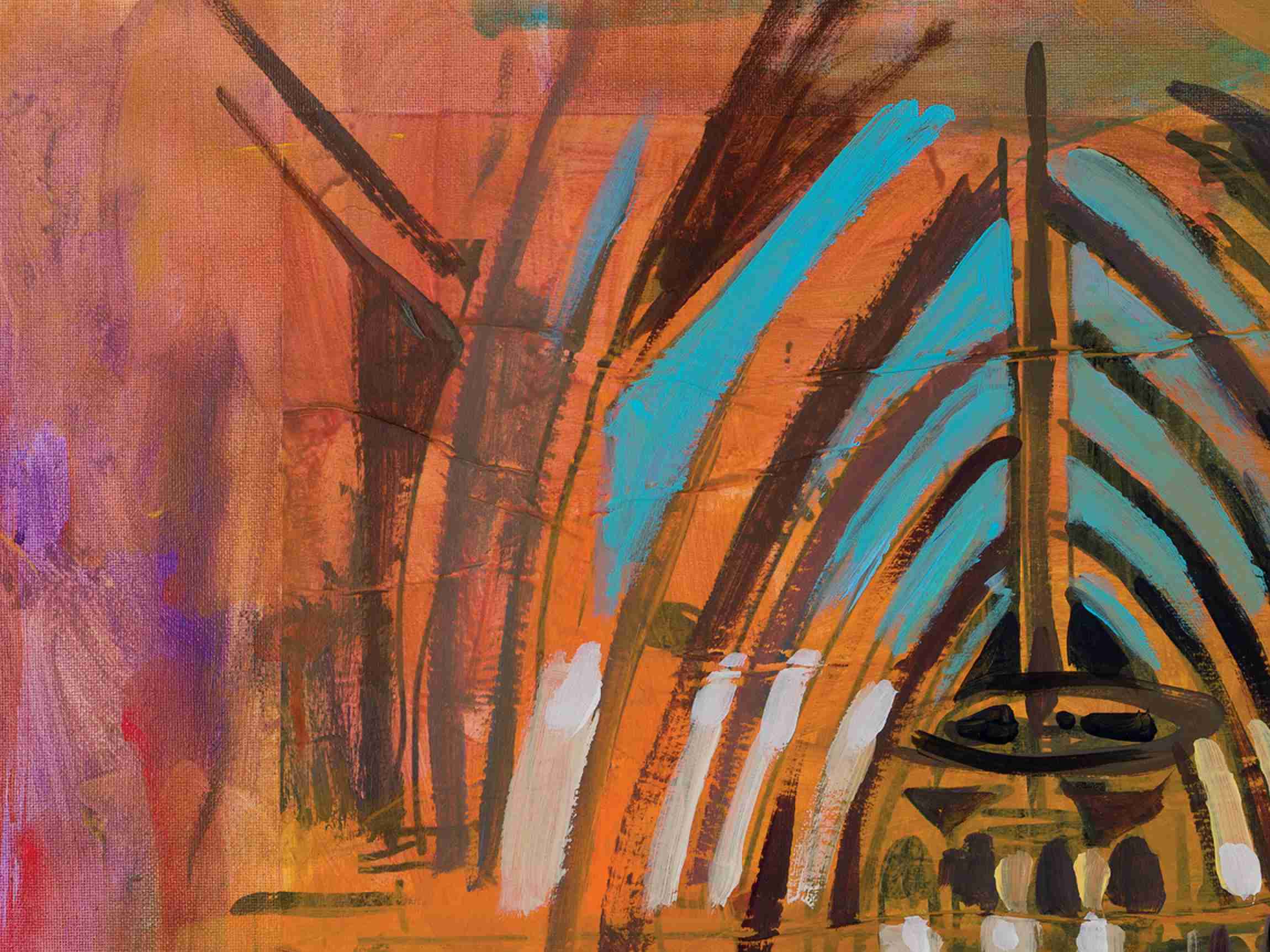

ALAIN LOCKE
BORN: SEPTEMBER 13, 1885, PHILADELPHIA, PENNSYLVANIA
DIED: JUNE 9, 1954, NEW YORK CITY
WRITER, EDUCATOR, PHILOSOPHER
I REMEMBER BEING A KID and learning about the Greek philosophers Aristotle and Plato. And as you know from reading this book, it was thought that W. E. B. Du Bois was one of our greatest American philosophers. In my research for Flamboyants, I found those three names referenced in an unpublished speech by Martin Luther King Jr. given in Mississippi in 1968. But the fourth name he mentioned, I had never heard before: That name was Alain Locke.
Did you know that Bayard Rustin, a Black gay man, was the architect for the March on Washington and Martin Luther King Jr.’s right-hand man? Alain and Bayard are further proof that Black queer people have been at the forefront of cultural shifts and creativity within the Black community—better yet, throughout the world—for generations. They refute the notion that queerness in Blackness is a new thing. Black queer people have been in the trenches from the very beginning.
Alain knew that he was gay, although he didn’t really live in that truth publicly. I imagine this was once again due to sodomy laws and society’s rejection of queerness, outside of its reflections in the arts of that time. It was almost like a don’t-ask-don’t-tell environment. Alain never married and never had children. But he did maintain relationships with many of the queer writers and artists he collaborated with.
Alain was actually born Arthur, and his ancestors were free Blacks. This information is really important, because slavery isn’t taught with any nuance in schools. Many Blacks today are direct descendants of enslaved people who lived in the South. Before the Emancipation Proclamation and the Thirteenth Amendment, however, there were also some free Black people in the South as well as in the North. But to be clear, some enslaved people lived in the North as well. Popular history often makes it seem like the North was free and the South was enslaved. However, it wasn’t that simple. Free Blacks existed among those who were enslaved in all states.
At sixteen, Arthur changed his name to Alain. I’m not sure why, but Alain also used to say his birth year was 1886 instead of 1885. Biographers haven’t conclusively figured out why this occurred. However, this does remind me of the fact that my grandmother Nanny used to get teased by her sister because she had two birth certificates with a different date of birth. Suffice it to say, I’ll never know why that happened, either.
Alain graduated with degrees in philosophy and English from Harvard University. He was the first African American to be accepted as a Rhodes Scholar. Here we go once again with Black queers being the first. However, that accomplishment was met with oppression: Because of racism, he was initially denied enrollment at Oxford University. Eventually, Hertford College took him on, and Alain continued his studies there in philosophy and Latin. In 1912, he began teaching as an assistant professor of English at Howard University, one of the historically Black colleges and universities (HBCUs). There he also joined Phi Beta Sigma, a Black fraternity. He finished his education at Harvard University in 1918, earning a PhD in philosophy.
After getting his doctorate, he worked at Howard University as the chair of the philosophy department. Alain had a passion for mentoring and teaching Black youth. It was something he felt Black communities needed if Black people were to ever gain equity in society. He once said:
The Younger Generation comes, bringing its gifts. They are the first fruits of the Negro Renaissance. Youth speaks, and the voice of the New Negro is heard.
This relates back to the “talented tenth” principle I discussed earlier. However, Alain’s philosophy was less about assimilating to white culture and more about self-empowerment. Which is why he eventually caused a major controversy at Howard.
Alain was let go in 1925 after fighting the administration for equal pay for Black professors. At the time, white professors were earning more money than their Black colleagues—at an HBCU. This sparked my interest as a two-time HBCU alum myself (Virginia Union University and Bowie State University). HBCUs were created because white people wouldn’t allow Black students to attend their institutions, so we created our own. Although they are extremely important to the education of Black communities, many HBCUs still promoted assimilation, respectability politics, homophobia, misogyny, and more—mirroring the intellectual culture during the Harlem Renaissance.
I can’t imagine being a Black professor—the first Black Rhodes Scholar with a PhD from Harvard—at an institution created for the betterment of Black people and not being paid equal to my white colleagues with fewer accolades or credentials. But that’s the world we still live in today. However, I truly believe that things happen how they are supposed to happen. Because during his exit from Howard, Alain began working on a new project. In 1925, he served as guest editor for Survey Graphic, which called itself a “magazine of social interpretation.” The March issue was a special edition titled “Harlem: Mecca of the New Negro.”
Locke turned his work for Survey Graphic into a book titled The New Negro: An Interpretation later that year. This anthology included nonfiction essays, stories, and poetry by some of THEE greatest figures of the Harlem Renaissance. Pieces by Zora Neale Hurston, Countee Cullen, Langston Hughes, Claude McKay, and others were included in this now-famous text. Also notice how much queer influence Alain’s book had.
I wish we were given the opportunity—especially as Black students—to read these types of books in school. As a Black teen, how do you know where you are going if you don’t even know where your people have been? Our history lessons often went straight from American slavery to the civil rights movement. But do you see how much Black and queer history is missed if you skip the Harlem Renaissance?
We are too disconnected from our roots. I remember young Black folks in 2016 wearing T-shirts that said, “I am not my grandparents. I will use these hands,” suggesting that folks would be willing to physically fight against white supremacy, unlike their pacifist grandparents. However, this assumption that older generations were pacifists is simply not true.
Many of our ancestors shed blood fighting for their lives and livelihoods, taking on great danger. Nat Turner led the nation’s deadliest slave rebellion in 1831 and was hung to death and skinned afterward. Fannie Lou Hamer was beaten and arrested for fighting for civil rights after teaching a voter education workshop. And during the infamous “Bloody Sunday” on the Edmund Pettus Bridge, six hundred Black civil rights protesters were attacked violently by the police. The New Negro gives a lot of context to the post-slavery movement, and how we could build on our successes as a race without adjusting to white people’s demands or assimilating into their culture, following their ideas on how we should live.
For Alain Locke, the “Old Negro” was the vessel for all the trauma and stigma and stereotypes of enslavement. The “New Negro” was the Black person who had self-awareness and self-respect. The New Negro’s independence was a result of not only that self-awareness and self-respect but also the end of slavery and the start of the migration north. The New Negro represented renewal and rebirth—hence Renaissance—and the refusal to accept white people’s bidding.
The Great Migration was central to my family’s story, too. Our ancestors are primarily from Virginia and South Carolina. During the 1930s and ’40s, a lot of my family began making routes north, primarily to New Jersey, where most of us are now. For Alain Locke, the migration represented the movement of Black people in all areas of life. It was our restart. It was the Negro of the South aligning with the Negro of the North, and the two creating a new world for Black folks.
When I read Alain’s work now, it makes me yearn to read more Black writers of the past. To know what people felt and what they thought—whether you agree or disagree—often births new ideas. It also helps us take those things from the past, apply them to where we are today, and create a better future. I love how Alain understood that a lot of the work we do in the present is not about the generation we live in, but for future generations we may never know. It’s why many of us writers do what we do. I write for our time, to help those here today. But the real work is done with the kid I’ll never know a hundred years from now. And that person can use their work to help a kid one hundred years after that. Alain put it this way:
The younger generation is vibrant with a new psychology; the new spirit is awake in the masses … Each generation … will have its creed.
A year after Alain was fired, Howard hired its first Black president, Mordecai Johnson. (Many HBCUs had white presidents and leadership. Some colleges were even founded by those white leaders, but that’s another book for another day.) Mordecai reinstated Alain in 1928. Alain would teach there for the next twenty-five years, influencing generations long after his own. He continued to support and collaborate with other artists throughout the rest of his life.
Alain Locke is the key—pun intended. He was the key to success for many of his students, and the key to opening the world to the life of Black folks in a way we had never seen before.